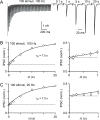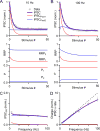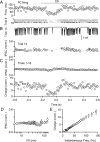Synaptic Specializations Support Frequency-Independent Purkinje Cell Output from the Cerebellar Cortex
- PMID: 28009294
- PMCID: PMC5870134
- DOI: 10.1016/j.celrep.2016.11.081
Synaptic Specializations Support Frequency-Independent Purkinje Cell Output from the Cerebellar Cortex
Abstract
The output of the cerebellar cortex is conveyed to the deep cerebellar nuclei (DCN) by Purkinje cells (PCs). Here, we characterize the properties of the PC-DCN synapse in juvenile and adult mice and find that prolonged high-frequency stimulation leads to steady-state responses that become increasingly frequency independent within the physiological firing range of PCs in older animals, resulting in a linear relationship between charge transfer and activation frequency. We used a low-affinity antagonist to show that GABAA-receptor saturation occurs at this synapse but does not underlie frequency-invariant transmission. We propose that PC-DCN synapses have two components of release: one prominent early in trains and another specialized to maintain transmission during prolonged activation. Short-term facilitation offsets partial vesicle depletion to produce frequency-independent transmission.
Keywords: Purkinje cells; TPMPA; cerebellum; deep cerebellar nucleus; presynaptic; receptor saturation; recovery from depression; short-term facilitation.
Copyright © 2016 The Author(s). Published by Elsevier Inc. All rights reserved.
Figures







Similar articles
-
A Slow Short-Term Depression at Purkinje to Deep Cerebellar Nuclear Neuron Synapses Supports Gain-Control and Linear Encoding over Second-Long Time Windows.J Neurosci. 2020 Jul 29;40(31):5937-5953. doi: 10.1523/JNEUROSCI.2078-19.2020. Epub 2020 Jun 17. J Neurosci. 2020. PMID: 32554551 Free PMC article.
-
Perineuronal Nets in the Deep Cerebellar Nuclei Regulate GABAergic Transmission and Delay Eyeblink Conditioning.J Neurosci. 2018 Jul 4;38(27):6130-6144. doi: 10.1523/JNEUROSCI.3238-17.2018. Epub 2018 Jun 1. J Neurosci. 2018. PMID: 29858484 Free PMC article.
-
Efficacy and short-term plasticity at GABAergic synapses between Purkinje and cerebellar nuclei neurons.J Neurophysiol. 2003 Feb;89(2):704-15. doi: 10.1152/jn.00558.2002. J Neurophysiol. 2003. PMID: 12574448
-
Retrograde endocannabinoid signaling in the cerebellar cortex.Cerebellum. 2006;5(2):134-45. doi: 10.1080/14734220600791477. Cerebellum. 2006. PMID: 16818388 Review.
-
GABA-ergic transmission in deep cerebellar nuclei.Prog Neurobiol. 1997 Oct;53(2):259-71. doi: 10.1016/s0301-0082(97)00033-6. Prog Neurobiol. 1997. PMID: 9364613 Review.
Cited by
-
Myelination synchronizes cortical oscillations by consolidating parvalbumin-mediated phasic inhibition.Elife. 2022 Jan 10;11:e73827. doi: 10.7554/eLife.73827. Elife. 2022. PMID: 35001871 Free PMC article.
-
Plasticity leading to cerebellum-dependent learning: two different regions, two different types.Pflugers Arch. 2019 Jul;471(7):927-934. doi: 10.1007/s00424-019-02282-3. Epub 2019 May 19. Pflugers Arch. 2019. PMID: 31104128 Review.
-
Kinetics of transmitter release at the calyx of Held synapse.Proc Jpn Acad Ser B Phys Biol Sci. 2018;94(3):139-152. doi: 10.2183/pjab.94.010. Proc Jpn Acad Ser B Phys Biol Sci. 2018. PMID: 29526973 Free PMC article. Review.
-
The readily releasable pool of synaptic vesicles.Curr Opin Neurobiol. 2017 Apr;43:63-70. doi: 10.1016/j.conb.2016.12.012. Epub 2017 Jan 16. Curr Opin Neurobiol. 2017. PMID: 28103533 Free PMC article. Review.
-
Distinct temporal filters in mitral cells and external tufted cells of the olfactory bulb.J Physiol. 2017 Oct 1;595(19):6349-6362. doi: 10.1113/JP274608. J Physiol. 2017. PMID: 28791713 Free PMC article.
References
Publication types
MeSH terms
Substances
Grants and funding
LinkOut - more resources
Full Text Sources
Other Literature Sources
Medical
Miscellaneous

